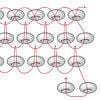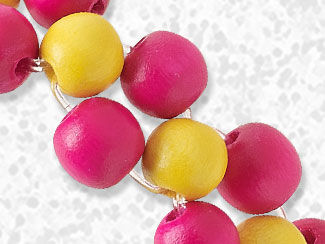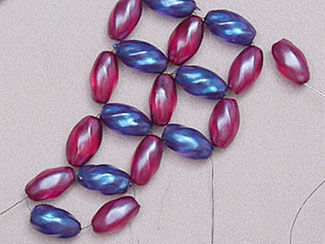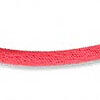Search Results For "weaverd"
Alphabetical List of Jewelry-Making Terms
All
a
b
c
d
e
f
g
h
i
j
k
l
m
n
o
p
q
r
s
t
u
v
w
x
y
z
Weaving techniques adapted to create a flexible "fabric" out of seed beads and thread using a needle and thread.

Seed beads are woven between the warp threads on a Beading Loom to create a design or pattern that becomes a flexible "fabric."

An off-loom bead-weaving technique. In brick stitch, beads are woven in a pattern like a brick wall. Also called Cheyenne or Comanche stitch.

A popular bead weaving technique in jewelry making, brick stitch involves adding beads in
an offset pattern to create a flat, tightly woven fabric. This stitch resembles the layout of bricks in a wall, where each bead is positioned between two beads in the previous row. Brick stitch is versatile and can be used to create intricate patterns, shapes, and designs in bracelets, earrings, pendants and other beaded jewelry pieces. It is known for its durability and the ability to form both geometric and freeform designs.

(see also Bead Weaving, On-Loom) The process of using seed beads woven between the warp threads on a Beading Loom, to create a design or pattern.

Nylon beading thread produced by the Belding Corticelli Company. Extremely fine thread popularly used in seed bead on-loom and off-loom bead weaving projects.

An off-loom bead-weaving technique used by many cultures, in which beads are woven in a zigzag. Peyote stitch has both flat and tube-shaped variations.

Using two needles, one on each end of the thread, string three beads on one of the needles and slide them to the center of the thread. String a fourth bead, passing one needle through from left to right and passing the other needle through from right to left. String one bead with each needle, then pick up one more bead and pass one needle through from left to right and pass the other needle through from right to left. Continue for desired length of row. To work the next row, repeat as for the first row, stringing new beads only onto the right thread and passing back through beads from the first row with the left thread.
To make a row-end decrease, simply stop your row short and begin a new row.

The right angle weave (RAW) is a basic jewelry-making stitch often used with seed beads and crystal beads. String 4 beads and pass through them again to form the first unit. For the rest of the row, string 3 beads, pass through the last bead passed through in the previous unit, and the first two just strung; the thread path will resemble a figure-8, alternating directions with each unit. To begin the next row, pass through the last 3 beads strung to exit the side of the last unit. String 3 beads, pass through the last bead passed through, and the first bead just strung. *String 2 beads, pass through the next edge bead of the previous row, the last bead passed through in the previous unit, and the last 2 beads just strung. Pass through the next edge bead of the previous row, string 2 beads, pass through the last bead of the previous unit, the edge bead just passed through, and the first bead just strung. Repeat from * to complete the row then begin a new row as before.

A form of weaving that creates a material with a glossy surface and a matte back. Commonly used in formal dress material, ribbon and cording.
